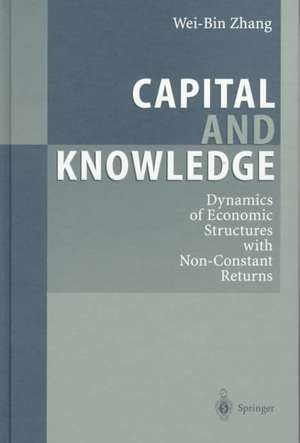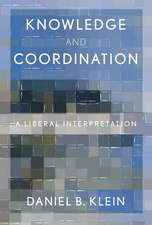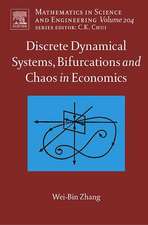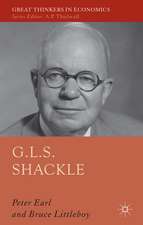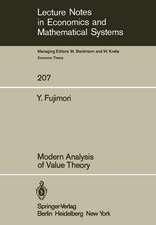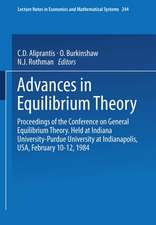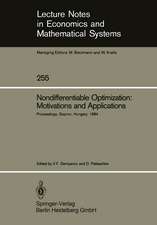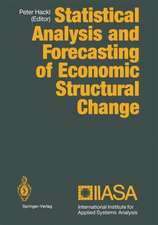Capital and Knowledge: Dynamics of Economic Structures with Non-Constant Returns
Autor Wei-Bin Zhangen Limba Engleză Hardback – 21 ian 1999
| Toate formatele și edițiile | Preț | Express |
|---|---|---|
| Paperback (1) | 647.92 lei 6-8 săpt. | |
| Springer Berlin, Heidelberg – 8 oct 2012 | 647.92 lei 6-8 săpt. | |
| Hardback (1) | 654.12 lei 6-8 săpt. | |
| Springer Berlin, Heidelberg – 21 ian 1999 | 654.12 lei 6-8 săpt. |
Preț: 654.12 lei
Preț vechi: 769.55 lei
-15% Nou
Puncte Express: 981
Preț estimativ în valută:
125.18€ • 135.93$ • 105.15£
125.18€ • 135.93$ • 105.15£
Carte tipărită la comandă
Livrare economică 22 aprilie-06 mai
Preluare comenzi: 021 569.72.76
Specificații
ISBN-13: 9783540651345
ISBN-10: 3540651349
Pagini: 448
Ilustrații: XI, 431 p.
Dimensiuni: 155 x 235 x 30 mm
Greutate: 0.8 kg
Ediția:1999
Editura: Springer Berlin, Heidelberg
Colecția Springer
Locul publicării:Berlin, Heidelberg, Germany
ISBN-10: 3540651349
Pagini: 448
Ilustrații: XI, 431 p.
Dimensiuni: 155 x 235 x 30 mm
Greutate: 0.8 kg
Ediția:1999
Editura: Springer Berlin, Heidelberg
Colecția Springer
Locul publicării:Berlin, Heidelberg, Germany
Public țintă
ResearchCuprins
1 Introduction.- 1.1 Classical Economics.- 1.2 General Equilibrium Theory.- 1.3 Neoclassical Growth Theory.- 1.4 Disequilibrium Economics.- 1.5 Economic Structure.- 1.6 Economics with Returns to Scale.- 1.7 Modern Vision of Economic Processes by Complex Theory.- 1.8 Structure of the Study.- 2 One-Sector Growth Models under Constant Returns to Scale.- 2.1 The One-Sector Growth Model.- 2.2 Growth with Home Capital.- 2.3 Time Distribution in the One-Sector Growth Model.- 2.4 Conclusions.- A. 2.1 Production Functions in Growth Theory.- A. 2.2 Preference and Utility Functions.- A. 2.3 The Solow-Swan Model.- A. 2.4 The Ramsey Growth Model.- 3 One-Sector Economies under Non-Constant Returns to Scale.- 3.1 The Growth Model with Public Goods.- 3.2 Knowledge, Population, Environment and Economic Growth.- 3.3 An Economic Dynamics with Livestock.- 3.4 Economic Development with Human Capital and Opening.- 3.5 On Returns to Scale.- A. 3.1 Economic Growth with Money.- A. 3.2 Economic Chaos with Endogenous Population.- 4 Knowledge, Growth and Economic Structures.- 4.1 An Agricultural Economy with Land Ownership Distribution.- 4.2 A Two-Sector Ricardian Economy.- 4.3 The Ricardian System with Knowledge and Infrastructures.- 4.4 A Structural Dynamics of Agriculture, Industry and Service.- 4.5 Economic Structure with Multiple Capital Goods.- 4.6 On Economic Structures.- A. 4.1 The Neoclassical Two-Sector Growth Model.- A.4.2 The Neoclassical Multiple Sector Models.- A.4.3 Proving Proposition 4.2.1.- A.4.4 Proving Proposition 4.4.1.- A.4.5 Proving Proposition 4.5.1.- 5 Knowledge, Growth and Wealth Distribution.- 5.1 Income Distribution with Human Capital, Diligence and Frugality.- 5.2 Growth with Government’s Redistribution Policy.- 5.3 Economic Structure with Multiple Groups and JobAmenities.- 5.4 A Two-Group Growth Model with Capital and Knowledge.- 5.5 On Economic Evolution with Multiple Groups.- A.5.1 Distribution of Income and Wealth in Sato’s Model.- A.5.2 Proving Propositions 5.1.1 and5.1.2.- A.5.3 Proving Proposition 5.3.1.- A.5.4 Proving Proposition 5.4.1.- 6 Education, Research and Growth.- 6.1 Education and Saving in the Growth Model.- 6.2 The Research Model with Job Amenities.- 6.3 The Two-Group Model with Research and Job Amenities.- 6.4 Growth with Capital, Human Capital and Knowledge.- A.6.1 Proving Proposition 6.1.1.- 7 Unemployment in Disequilibrium Dynamics.- 7.1 Growth and Unemployment in a Two-Group Economy.- 7.2 Unemployment with Endogenous Knowledge.- 7.3 Unemployment in a ‘Welfare Economy’.- 7.4 Conclusions.- A. 7.1 Proving Lemmas 7.1.3 and 7.1.4 and Examining the Case of Different Preferences.- A. 7.2 Proving Proposition 7.2.1.- 8 Economic Development with Sexual Division of Labor.- 8.1 Sexual Division of Labor with Home Capital and Time Distribution.- 8.2 The Impact of Female Labor Participation on Knowledge Economies.- 8.3 Sexual Division of Labor with Capital and Knowledge.- 8.4 Economic Growth with Sexual Discrimination.- 8.5 On Complex of Sexual Division of Labor and Consumption.- A.8.1 Proving Lemmas 8.1.3 and 8.1.4.- A.8.2 Proving Lemma 8.2.1.- A.8.3 Proving Propositions 8.3.1 and 8.3.2.- 9 Preference Change with Capital and Knowledge.- 9.1 Preference Change in the One-Sector Growth Model.- 9.2 Dynamics of Capital, Knowledge and Preference.- 9.3 Dynamic Economic Structure with Preference Change.- 9.4 Growth and Preference Change with Sexual Division of Labor.- 9.5 Concluding Remarks.- 10 Summary.- Name Index.
Caracteristici
The author tries to combine different economic theories to a new theory that can explain economic phenomena which cannot be explained by traditional works
